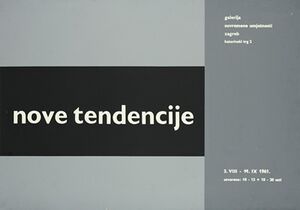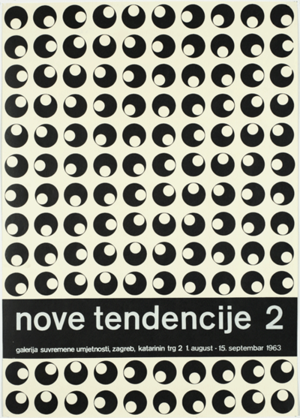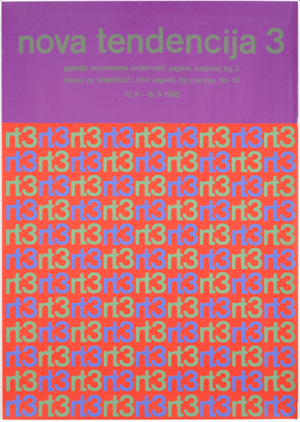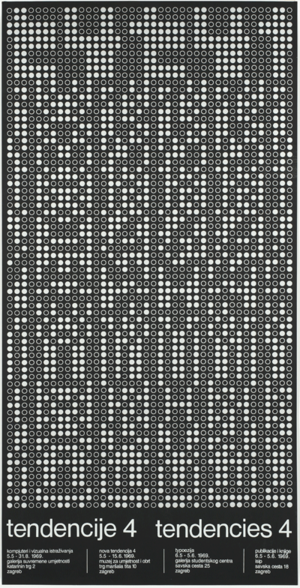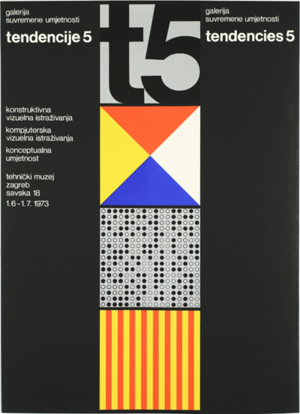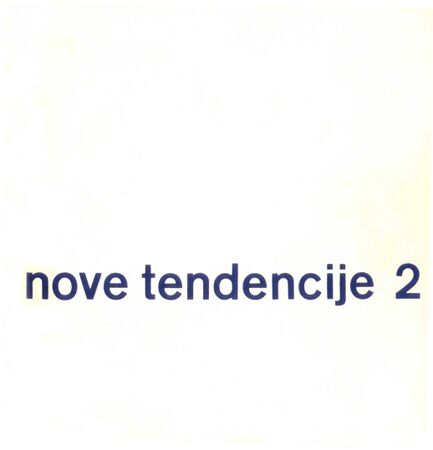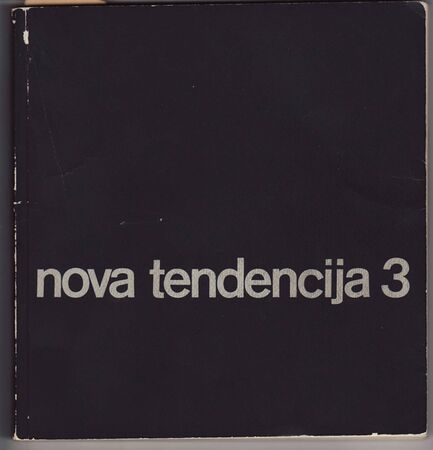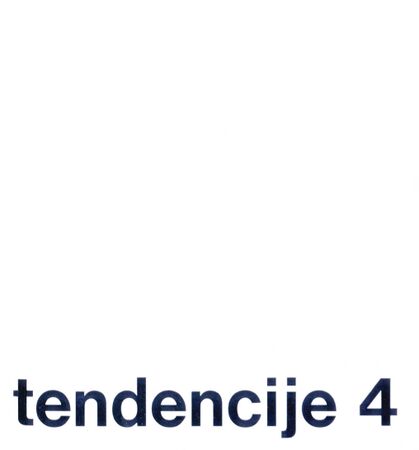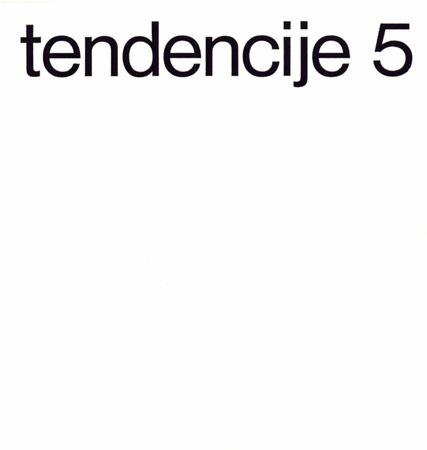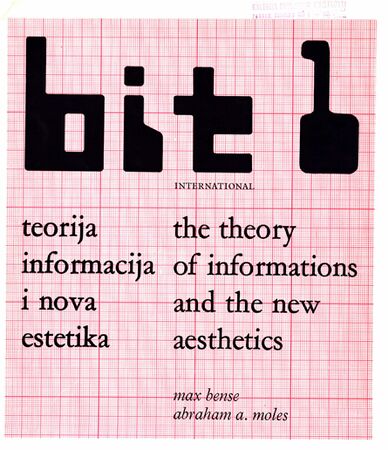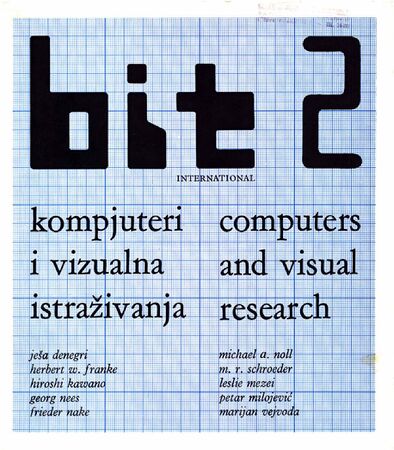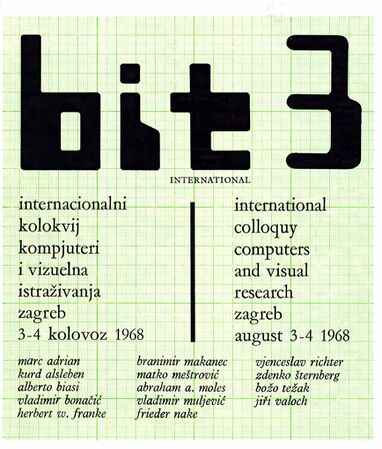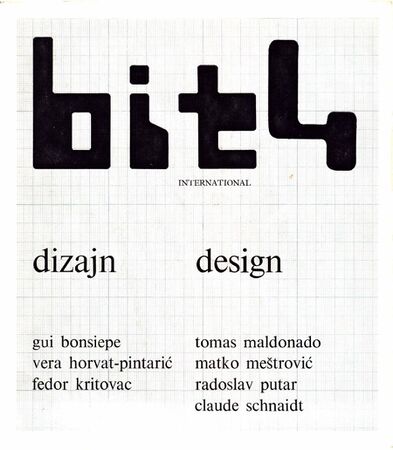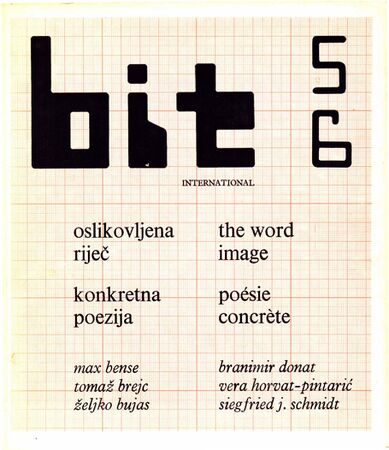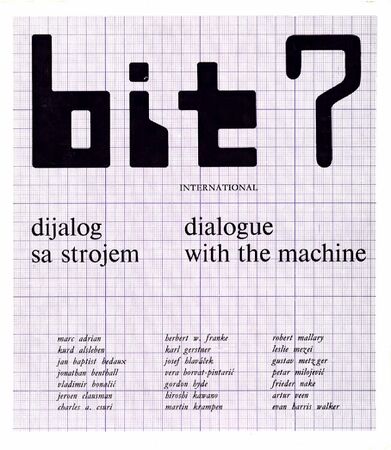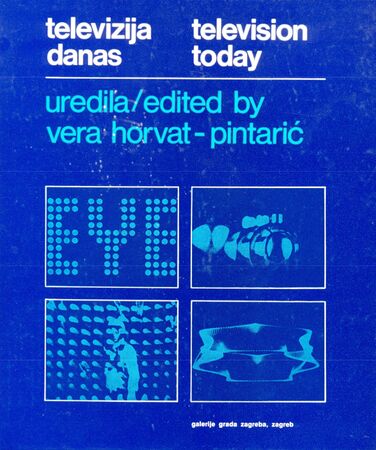New Tendencies
During the period 1961-1973, five international exhibitions were organized under the title New Tendencies in Zagreb, Croatia/Yugoslavia. They continued the development of ideas raised by Exat 51 during the 1950s, and formed part of the broader European post-informel art movement in the 1960s and 70s.
Contents
- 1 Exhibitions
- 1.1 Nove tendencije - New Tendencies, 1961
- 1.2 Nove tendencije 2 - New Tendencies 2, 1963
- 1.3 Nova tendencija 3 - New Tendency 3, 1965
- 1.4 Tendencije 4 - Tendency 4, 1968-69
- 1.5 Tendencije 4, Nove tendencije 4 - Tendencies 4, New Tendency 4, 1969
- 1.6 Tendencies 4, Computer and Visual Research, 1969
- 1.7 Tendencije 5 - Tendencies 5, 1973
- 2 Colloquia, symposia
- 3 Darko Fritz on New Tendencies
- 4 Publications
- 5 Retrospective exhibitions
- 6 Literature
- 7 Documentary films
- 8 Links
Commencing with the 1961 exhibition of concrete and constructive art Nove tendencije in Zagreb, the New Tendencies developed into a dynamic movement dedicated to visual research. Around the mid-1960s, the New Tendencies triggered an international Op-Art-boom, which was endorsed by participation in an exhibition entitled The Responsive Eye, at the New York MoMA, in 1965. However, success brought the New Tendencies no closer to its aims: the assertion of 'art as research' and the establishment of new forms of distribution beyond the art market, which should be accessible to everyman. The organizers of the New Tendencies decided to bring their strategy up-to-date and, in the summer of 1968, initiated in the context of the fourth exhibition, Tendencije 4, the program Computer and Visual Research. In 1968 the movement decided to incorporate into its program the computer as a medium of artistic work so as to thereby assert its avantgarde claim and to contribute to the definition of a technology which, as one quite rightly presumed, would define the future of civilization. Until 1973 the supporting institution of the New Tendencies, the former Gallery of Contemporary Art Zagreb – today the Museum of Contemporary Art – had dedicated itself to artistic research by computer with a series of international exhibitions and symposia. At the peak of the Cold War artists and scientists throughout the world presented their work in Zagreb. The New Tendencies thus established a unique platform for the exchange of ideas and experiences from the area of art, the natural sciences and engineering. With the multi-lingual journal Bit International (1968-73, 9 numbers) Zagreb became a point of initiation for aesthetics and media-theoretical thought.
The organizers of NT initially sought to consciously accompany and form the historical transition in which the computer was perceived as medium of artistic creation. They set computer generated works in relation to Constructive and Kinetic art (1968/69) and to Conceptual art (1973). The arts of the electronic media were not considered as an isolated phenomenon but rather incorporated into the history and discourse of fine-and performing arts. (Source)
Exhibitions
Nove tendencije - New Tendencies, 1961
Exhibition, Galerija suvremene umjetnosti, Gallery for Contemporary Art, Zagreb, 3 August – 14 September 1961.
- Participating artists
Marc Adrian (AT), Alberto Biasi (IT), Enrico Castellani (IT), Ennio Chiggio (IT), Andreas Christen (CH), Toni Costa (IT), Piero Dorazio (IT), Karl Gerstner (CH), Gerard von Graevenitz (DE), Rudolf Kämmer (DE), Julije Knifer (YU-CR), Edoardo Landi (IT), Julio Le Parc (AR/FR), Heinz Mack (DE), Piero Manzoni (IT), Manfredo Massironi (IT), Almir Mavignier (BR/DE), François Morellet (FR), Gotthart Müller (DE), Herbert Oehm (DE), Ivan Picelj (YU-CR), Otto Piene (DE), Uli Pohl (DE), Dieter Rot (DE), Joël Stein (FR), Paul Talman (CH), Günther Uecker (DE), Marcel Wyss (CH), Walter Zehringer (DE).
Nove tendencije 2 - New Tendencies 2, 1963
Exhibition, Galerija suvremene umjetnosti, Gallery for Contemporary Art, Zagreb, 1 August – 15 September 1963.
- Participating artists
Marc Adrian (AT), Getulio Alviani (IT), Vojin Bakić (YU-CR), Martha Boto (AR/FR), Enrico Castellani (IT), Andreas Christen (CH), Toni Costa (CH), Cruz-Diez (VE/FR), Hugo Rodolfo Demarco (AR), Piero Dorazio (IT), Equipo 57 (Juan Cuenca, Ángel Duarte, José Duarte, Agustín Ibarrola, Juan Serrano) (ES), Héctor Garcia-Miranda (AR), Karl Gerstner (CH), Gerard von Graevenitz (DE), Groupe de Recherche d’art Visuel (Julio Le Parc (AR/FR), François Morellet (FR), Garcia Rossi (AR), Francisco Sobrino (ES/FR), Joël Stein (FR), Yvaral (FR)), Gruppo N (Alberto Biasi, Ennio Chiggio, Edoardo Landi, Manfredo Massironi) (IT), Gruppo T (Giovanni Anceschi, Davide Boriani, Gianni Colombo, Grazia Varisco, Gabriele De Vecchi) (IT), Dieter Hacker (DE), Rudolf Kämmer (DE), Julije Knifer (YU-CR), Vlado Kristl (YU-CR), Heinz Mack (DE), Enzo Mari (IT), Almir Mavignier (BR/DE), Gotthart Müller (DE), Herbert Oehm (DE), Henk Peeters (NL), Ivan Picelj (YU-CR), Otto Piene (DE), Uli Pohl (DE), Karl Reinhartz (DE), Vjenceslav Richter (YU-CR), Aleksandar Srnec (YU-CR), Klaus Staudt (DE), Helge Sommerrock (DE), Miroslav Šutej (YU-CR), Paul Talman (CH), Luis Tomasello (AR/FR), Günther Uecker (DE), Gregorio Vardanega (IT/AR/FR), Ludwig Wilding (DE), Walter Zehringer (DE).
Nova tendencija 3 - New Tendency 3, 1965
Exhibition, Galerija suvremene umjetnosti, Muzej za umjetnost i obrt, Gallery for Contemporary Art, Museum for Art and Work, Zagreb, 13 August – 3 October 1965.
- Participating artists
Marc Adrian (AT), Getulio Alviani (IT), Anonima Group (Ernst Benkert) (US), Francis Hewitt (US), Edwin Mieczkowski (US), Marina Apollonio (IT), Marianne Aue (NL), Hartmut Böhm (DE), Bonies (Bob Niewenhuis) (NL), Martha Boto (AR/FR), Gruppo Di Ricerca Cibernetica (IT), Inge Claus-Jansen (DE), Waldemar Cordeiro (IT/BR), Ivan Čižmek (YU-CR), Dadamaino (IT), Juraj Dobrović (YU-CR), Dvizheniye (Vladimir Petrovič Galkin, Francisco Arana Infante, Georgij Ivanovič Lopakov, Lev Voldemarovič Nusberg, Viktor Vladimirovič Stepanov) (RU), Effekt (DE), Gruppo N (Alberto Biasi, Manfredo Massironi) (IT), Equipo 57 (Juan Cuenca, Ángel Duarte, José Duarte, Agustin Ibarrola, Juan Serrano) (ES), Eronda (IT), Cam Estenfelder (DE), Karl Gerstner (CH/DE), Jürgen Graaf (DE), Gerard von Graevenitz (DE), Tom Hudson (UK), Reimer Jochims (DE), Rudolf Kaemmer (DE), Ed Kiënder (DE), Hans König-Klingenberg (DE), Edward Krasinski (PL), Bernard Lassus (FR), Lucia Di Luciano (IT), Wolfgang Ludwig (DE), Frank Joseph Malina (US), Kenneth Martin (UK), Gruppo MID (IT), François Morellet (FR), Bruno Munari (IT), Koloman Novak (YU-CR/SR), Fedora Orebić (YU-CR), Henk Peeters (NL), Helga Philip (AT), Ivan Picelj (YU-CR), Otto Piene (DE), Giovanni Pizzo (IT), Lothar Quinte (DE), Vjenceslav Richter (YU-CR), Bridget Riley (UK), Christian Roeckenschuss (DE), Dieter Rot (DE), Paolo Scheggi (IT), Turi Simeti (IT), Ed Sommer (DE), Klaus Staudt (DE), Zdeněk Sýkora (CS-CZ), Sándor Szandaï (HU), Gruppo T (Giovanni Ancheschi, Davide Boriani, Gianni Colombo, Gabriele De Vecchi) (IT), Erwin Thorn (AT), Ivanhoe Trivulzio (IT), Gregorio Vardanega (IT/FR), Emilio Vedova (IT), Nanda Vigo (IT), herman de vries (NL), Ante Vulin (YU-CR), Ludwig Wilding (DE).
Tendencije 4 - Tendency 4, 1968-69
Tendencije 4 - Tendency 4, 1968
Tendencije 4, Kompjutori i vizuelna istraživanja - Tendency 4, Computer and Visual Research.
Informational exhibition featuring computer graphics and programmed works, Centar za kulturu i informacije [Center for Culture and Information], Zagreb, 2–8 August 1968.
Tendencije 4, Nove tendencije 4 - Tendencies 4, New Tendency 4, 1969
Tendencije 4, Nove tendencije 4 (Retrospektiva NT 1 - NT 3; Recentni primjeri vizuelnih istraživanja) - Tendencies 4, New Tendency 4 (Retrospective of NT 1—NT3, Latest Examples of Visual Research),
Exhibition, Muzej za umjetnost i obrt [Museum of Art and Work], Zagreb, 5 May – 30 June 1969.
- Artists represented in Retrospective of NT 1—NT 3
Marc Adrian (AT), Getulio Alviani (IT), Vojin Bakić (YU-CR), Alberto Biasi (IT), Gianni Colombo (IT), Giovanni Antonio Costa (IT), Juraj Dobrović (YU-CR), Michel Fadat (FR), Rudolf Kämmer (DE), Julije Knifer (YU-CR), Vlado Kristl (YU-CR), Julio Le Parc (AR/FR), Heinz Mack (DE), Manfredo Massironi (IT), Almir Mavignier (BR/DE), François Morellet (FR), Helga Philip (AT), Ivan Picelj (YU-CR), Otto Piene (DE), Karl Reinhartz (DE), Vjenceslav Richter (YU-CR), Paolo Scheggi (IT), Aleksandar Srnec (YU-CR), Sándor Szandaï (HU), Miroslav Šutej (YU-CR), Paul Talman (CH), Gabriele De Vecchi (IT), Yvaral (FR).
- Artists participating in NT 4—Latest Examples of Research
Anonima Group (Ernst Benkert, Francis Hewitt, Edwin Mieczkowski) (US), Marina Apollonio (IT), Art Research Centre (John F. Abbick, Peter Clapp, Nancy A. Stephens, Thomas Michael Stephens, Jon Brees Thogmartin (all US), Philip J. Van Voorst (NL/US)), Otto Beckmann (RU/AT), Štefan Belohradský (CS-SK), Alberto Biasi (IT), Jiří Bielecki (CS-CZ), Hartmut Böhm (DE), Alessandro Carlini (IT/DE) and Bernhard Schneider (DE), Boris Cikalovski (YU-CR), Inge Claus-Jansen (DE), Gianni Colombo (IT/DE), Waldemar Cordeiro (IT/BR), Jarmila Čihánková (CS-CZ), Dadamaino (IT), Milan Dobeš (CS-SK), Juraj Dobrović (YU-CR), Angel Duarte (ES/CH), Herbert W. Franke (DE), Bruno Gambone (IT), Karl Gerstner (CH/DE), Rolf Glasmeier (DE), Hans Jörg Glattfelder (CH/IT), Hein Gravenhorst (DE), Dieter Hacker (DE), John Gabriel Harries (UK/IL), Axel Heibel (DE), Jiří Hilmar (CS-CZ), Gottfried Jäger (DE), Reimer Jochims (DE), Wohl Kahlen (DE), Rudolf Kämmer (DE), Tamara Klimová (CS-SK), Radoslav Kratina (CS-CZ), Richard Kriesche (AT), Edoardo Landi (IT), Wolfgang Ludwig (DE), Max Hermann Mahlmann (DE) and Gudrun Mahlmann-Piper (JP/DE), Gruppo MID (IT), Marcello Morandini (IT), Maurizio Nannucci (IT), Koloman Novak (YU-CR/AT), Luigi Pezzato (IT), Helga Philip (AT), Ivan Picelj (YU-CR), Otto Piene (DE), Zoran Radović (YU-SR), Karl Reinhartz (DE), Gruppo Richerche Cibernetiche (Vittorio D'Augusta, Eugenio Lombardini, Flavio Casade, Pino Parini, Giorgio Scarpa, Giulio Tedioli, Antonio Valmaggi) (IT), Vjenceslav Richter (YU-CR), Bernhard Sandfort (DE), Paolo Scheggi (IT), Aleksandar Srnec (YU-CR), Klaus Staudt (DE), Josef Herman Stiegler (AT), Sándor Szandaï (HU), Luis Tomasello (AR/FR), Jorrit Tornquist (AT), Miloš Urbásek (CS-SK), Grazia Varisco (IT), Gabriele De Vecchi (IT), herman de vries (NL).
Tendencies 4, Computer and Visual Research, 1969
Exhibition, Galerija suvremene umjetnosti [Gallery of Contemporary Art], Zagreb, 5 May–30 August 1969.
- Participating artists
Kurd Alsleben and Cord Passow (DE), Ars intermedia (Otto Beckmann (RU/AT), Alfred Grassl (AT)), Vladimir Bonačić (YU-CR), California Computer Products (Kerry Strand, Larry Jenkins, Doyle Cavin, Dee Hudson, Jane Moon) (US), Compos 68 (Jan Baptist Bedaux, Jeroen Clausman, Arthur Veen) (NL), Waldemar Cordeiro (IT/BR), Charles Csuri (US), Darel D. Eschbach (US), Willam Allan Fetter (US), Alan Mark France (UK), David R. Garrison (US), Jens Harke (DE), Leon D. Harmon and Kenneth C. Knowlton (US), Hiroshi Kawano (JP), Auro Lecci (IT), Robert Mallary (US), Gustav Metzger (DE/UK) (with D. E. Evans, Beverly Rowe and R. J. Stibbs (UK)), Leslie Mezei (HU/CA), Petar Milojević (YU-SR/CA), Frieder Nake (DE/CA), Georg Nees (DE), A. Michael Noll (US), Michael Palyka (US), Ivan Picelj (YU-CR), Rechenzentrum des Instituts Boris Kidrič, Vinča (YU-SR), Manfred Robert Schroeder (DE/US), Lloyd Quinton Summer (US), Alan Sutcliffe (UK), Zdeněk Sýkora (CS-CZ), Evan Harris Walker (US), Edward Zajec (IT/US).
Tendencije 4 - Tendencies 4, 1969
Tendencije 4, Izložba publikacija i knjiga - Tendencies 4, Exhibition of Publications and Books.
ISIP - Internacionalna stalna izložba publikacija, permanent exhibition of international publications, Zagreb, 6 May – 30 August 1969.
Tendencije 5 - Tendencies 5, 1973
Tendencije 5 (Konstruktivna vizuelna istraživanja; Kompjuterska vizuelna istraživanja; Konceptualna umjetnost) - Tendencies 5 (Constructive Visual Research, Computer Visual Research, Conceptual Art).
Exhibition, organized by the Galerija suvremene umjetnosti [Gallery of Contemporary Art], Zagreb. Tehnički muzej [Technical Museum], Zagreb, 1 June – 1 July 1973.
- Participating artists
Constructive Visual Research
Vojin Bakić (YU-CR),
Milan Dobeš (CS-SK),
Juraj Dobrović (YU-CR),
Julije Knifer (YU-CR),
Julio Le Parc (AR/FR),
Enzo Mari (IT),
Almir Mavignier (BR/DE),
François Morellet (FR),
Koloman Novak (YU-SR),
Lev Voldemarovič Nusberg (RU),
Zoran Radović (YU-SR),
Vjenceslav Richter (YU-CR),
Jesus Raphael Soto (VE/FR),
Aleksandar Srnec (YU-CR),
Miroslav Šutej (YU-CR),
Victor Vasarely (HU/FR).
Visual Research on Computer
Jose Luis Alexanco (ES),
Manuel Barbadillo (ES),
Otto Beckmann (AT),
Oskar Beckmann (AT),
Vladimir Bonačić (YU-CR),
Waldemar Cordeiro (IT/BR),
Gerardo Delgado (ES),
Fanie Dupré (FR),
Jacques Dupré (FR),
Winfried Fischer (DE),
Herbert W. Franke (DE),
David R. Garrison (US),
Jose Luis Gomez Perales (ES),
Jean-Claude Halgand (FR),
Grace C. Hertlein (US),
Miljenko Horvat (YU-CR/CA),
Hervé Huitric (FR),
Sture Johannesson and Sten Kallin (SW),
Auro Lecci (IT),
Jean-Claude Marquette (FR),
MBB Computer Graphics (Frank Böttger, Winfried Fischer, Sylvia Roubaud und Gerold Weiss, Johann Willsberger, Rolf Wölk (all DE), Aron Warszawski (IL/DE)),
Tomislav Mikulić (YU-CR),
Manfred Mohr (DE/FR),
Monique Nahas (FR),
Georg Nees (DE),
Sergej Pavlin (YU-SI),
Manuel Quejido (ES),
Ludwig Rase (DE),
Lillian Schwartz (US),
Ana and Javier Seguí (ES),
John Whitney (US),
Edward Zajec (IT),
Anton Zöttl (DE),
Vilko Žiljak (YU-CR).
Conceptual Art
Anonymous Collective (HU),
Giovanni Anselmo (IT),
John Baldessari (US),
Angelo Bozzolla (IT/UK),
Daniel Buren (FR),
Radomir Damnjanović-Damnjan (YU-SR),
Antonio Dias (BR/IT),
Braco Dimitrijević (YU-CR),
Barry Flanagan (UK),
Iannis Kounellis (GR/IT),
Douglas Huebler (US),
László Kerekes (YU-SR),
Sol LeWitt (US),
Slavko Matković (YU-SR),
Giulio Paolini (IT),
Giuseppe Penone (IT),
Reiner Ruthenbeck (DE),
Howard Selina (UK),
László Szalma (YU-SR),
Bálint Szombathy (YU-SR),
Ilija Šoškić (YU-ME),
Goran Trbuljak (YU-CR).
Colloquia, symposia
- 1962
November 3, 1962
New Tendencies artists meet at the studio of the Groupe de Recherche d' Art Visuel (GRAV), Paris
- 1965
August 18, 1965
Participants in NT3 meet
Castle Brezovica, Brezovica, near Zagreb
- 1968
ca May 1968
Jury meeting
3-4 August 1968
Tendencies 4, Computer and Visual Research
Colloquium and exhibition of publications on the same theme
Centar za kulturu i informacije, Center for Culture and Information, Zagreb
- 1969
January 10–12, 1969
Tendencies 4, Computer and Visual Research
Informational seminar
Organized in cooperation with the Yugoslavian section of the AICA (Association Internationale de Critique d'Art)
Centar za kulturu i informacije, Center for Culture and Information, Zagreb
May 5–6, 1969
Tendencies 4, Computer and Visual Research
International symposium
Radničko sveučilište Moša Pijade, Moša Pijade Workers' University, Zagreb
- 1971
June 26–27, 1971
Art and Computers 71
Colloquium
Radničko sveučilište Moša Pijade, Moša Pijade Workers' University Zagreb
- 1973
2 June 1973
Tendenzen 5 – The rational and irational in visual research today - Match of ideas
Symposion at the AICA Congress (Association Internationale de Critique d'Art)
Hotel Esplanade, Zagreb
- 1978
13-14 October 1978
Tendencies 6
International symposium
Centar za kulturu i informacije, Center for Culture and Information, Zagreb
Darko Fritz on New Tendencies
Between 1961 and 1973, the Gallery of Contemporary Art (now the Museum of Contemporary Art) organized five international exhibitions entitled New Tendencies. The first New Tendencies exhibition was organized on the initiative of the art historians Matko Meštrović, Radoslav Putar, Božo Bek and Boris Kelemen, and the artists Ivan Picelj and Almir Mavignier. The New Tendencies strived at a synthesis of different forms of the arts of the 1960s and 1970s. In the beginning, the movement characterized broad issues but later the exhibitions veered towards neo-constructivism, lumino-kinetic objects (mostly mechanically made, often under group authorship) and finally computer art and conceptual art. The first exhibition (1961) - apart from the participants such as Almir Mavignier, Zero Group (Oto Peine, Hienz Mack) and Azimuth Group (Enrico Castellani, Piero Manzoni) - contained works that were bent mostly on a system research (Francois Morellet, Karl Gerstner) and optical research of the surface and the structure of objects (Marc Adrian, Julio Le Park, Gunther Uecker, Gruppo N - Biasi, Massironi, Chiggio, Costa, Landi). The origins of the preprogrammed and kinetic art whose characteristic language would mark New Tendencies as a movement as early as their following exhibition (1963) had also been noted. The demands for the scientification of art favored experimenting with new technical media as a means of researching the visual perception based on the Gestalt theory. The third exhibition of New Tendencies (1965) probed the relationship between cybernetics and art and a symposium on the same topic preceded the exhibition. Vjenceslav Richter, Aleksandar Srnec and Ivan Picelj exhibited lumino-kinetic objects. The fourth exhibition (1968/69) was dominated by the information theory and encompassed an international conference entitled Kompjuteri i vizualna istrazivanja. The same year, the Gallery of Contemporary Art started the Bit international magazine. I have to mention the computer light installation by Vladimir Bonacic DIN.21 as a paradigm for media art coming from the sphere of science. The work was installed in 1968 on the facade of the NAMA department store in Zagreb and was intended as a permanent exhibit. In 1968, Vladimir Bonacic and Ivan Picelj realized T4, an electronic (and computer programmed) object. Beside the computerized visual research section, a conceptual art section was also included in Tendencies 5 (1973). Vilko Ziljak exhibited ASCCI photographs, i.e. digital printouts. Tomislav Mikulic, working for the television where he made intentional computer animation and television graphics, created an artistic computer movie 1973. In the early stages of the development of media art since the 1960s, we note two, at the time irreconcilable sources: modernist (supporting the idea of progress and science) and the anarchistic-individual approach of conceptual art (building on the achievements of the student movements from the 1960s). Conceptual art and computer art were prominently marked on the Tendencies 5 exhibition poster. Matko Mestrovic was the main theorist of New Tendencies as a movement who tackled the problem of the relationship between art and society demanding the socialization of arts, abolishing the unique significance of a work of art and equaling art and science. See more on Tendencies under Institutions, data bases, and the on-line catalogue of a collection of works of early computer art by MSU exhibited as part of the I Am Still Alive project (2000).
From: Darko Fritz, "A brief overview of media art in Croatia (since 1960s)", 2003.
Publications
Nove tendencije 2, 1963, PDF (63 mb).
Tendencije 4 / Tendencies 4, 1970, PDF (partial) (17 mb).
Tendencije 5 / Tendencies 5, 1973, PDF (55 mb).
Bit International, 1: The Theory of Informations and the New Aesthetics, 1968, PDF (7 mb).
Bit International, 2: Computers and Visual Research, 1968, PDF (22 mb).
Bit International, 3: International Colloquy Computers and Visual Research, 1968, PDF (23 mb).
Bit International, 4: Design, 1969, PDF (80 mb).
Bit International, 7: Dialogue with the Machine, 1971, PDF (30 mb).
Bit International, 8-9: Television Today, 1972, PDF (51 mb).
For alternative scans of Bit International, see the website of Moderna galerija Ljubljana.
Exhibition catalogues
- Nove tendencije 2, Zagreb: Galerija suvremene umjetnosti, 1963, [68] pp. Texts by Matko Meštrović and Radoslav Putar. (Serbo-Croatian)
- Nova tendencija 3, ed. Božo Bek, Zagreb: Galerija suvremene umjetnosti, 1965, [177] pp. Texts by Matko Meštrović, Rudi Supek, Giulio Carlo Argan, Umbro Aplonio, Palma Bucarelli, Maifredo Massironi, Giuseppe Gatt, Elisa Debenedetti, Rolf Wedewer, Ed Sommer, Vjenceslav Richter, Karl Gerstner, Emilio Vedova, Waldemar Cordeiro, Frank Popper, Miša Bašičević, Herman De Vries, Lev Nusberg, Francis Hewitt, Edwin Mieczkiovski, Paolo Bonaiuto, François Molnar, Abraham Moles. [1] (Serbo-Croatian)/(French),(German),(Italian),(English)
- Tendencije 4 / Tendencies 4: Zagreb, 1968-1969, eds. Boris Kelemen and Radoslav Putar, Zagreb: Galerija suvremene umjetnosti, 1970, [146] pp. Texts and statements by Radoslav Putar, Almir Mavignier, Matko Meštrović, Enzo Mari, Alessandro Carlini, Bernhard Schneider, Alberto Biasi, Gianni Colombo, Milan Dobeš, Herbert W. Franke, Karl Gerstner, Rolf Glasmeier, Rolf Gravenhorst, Hein Gravenhorst, Dieter Hacker, John Gabriel Harries, Gottfried Jäger, Richard Kriesche, Max H. Mahlmann, Marcello Morandini, Zoran Radović, Bernhard Sandfort, Paolo Scheggi, Klaus Staudt, Josef Hermann Stiegler, Jorrit Tornquist, Gabriele de Vecchi, Herman de Vries. (Serbo-Croatian)/(French),(German),(Italian),(English)
- Tendencije 5 / Tendencies 5, 2nd ed., eds. Božo Bek, Boris Kelemen and Marijan Susovski, Zagreb: Galerija suvremene umjetnosti, 1973, [137] pp. Texts by Radoslav Putar, Božo Bek, Boris Kelemen, Marijan Susovski, Nena Dimitrijević. (Serbo-Croatian)/(English)
Magazine
- Bit International: teorija informacija i nova estetika, 9 numbers (7 issues), ed. Božo Bek, Zagreb: Galerije grada Zagreba, 1968-72.
- 1, The Theory of Informations and the New Aesthetics / Teorija informacija i nova estetika, eds. Dimitrije Bašičević and Ivan Picelj, 1968, 129 pp. Texts by Matko Meštrović, Abraham A. Moles (3x), Max Bense, and Radoslav Putar. (Serbo-Croatian)/(English),(French),(German)
- 2, Computers and Visual Research / Kompjuteri i vizualna istraživanja, eds. Boris Kelemen and Radoslav Putar, 1968, 136 pp. Texts by Ješa Denegri, Herbert W. Franke, Hiroshi Kawano, Georg Nees, Frieder Nake, Michael A. Noll, M.R. Schroeder, Leslie Mezei, Petar Milojević, and Marijan Vejvoda. (Serbo-Croatian)/(English),(German)
- 3, International Colloquy Computers and Visual Research, Zagreb, August 3-4, 1968 / Internacionalni kolokvij kompjuteri i vizuelna istraživanja, 3-4 kolovoz 1968, eds. Boris Kelemen and Radoslav Putar, 1968, 143 pp. Texts by Abraham A. Moles (2x), Marc Adrian, Vjenceslav Richter, Alberto Biasi, Frieder Nake, Matko Meštrović, Vladimir Bonačić, Vladimir Muljević, Božo Težak, Branimir Makanec, Zdenko Šternberg, Jiří Valoch, Kurd Alsleben, Herbert W. Franke, and Leslie Mezei. (Serbo-Croatian)/(English),(French),(German),(Italian)
- 4, Design / Dizajn, ed. Matko Meštrović, 1969, 120 pp. Texts by Matko Meštrović, Tomas Maldonado (3x), Gui Bonsiepe (3x), Claude Schnaidt, Radoslav Putar, Vera Horvat-Pintarić, and Fedor Kritovac. (Serbo-Croatian)/(English)
- 5-6, The Word Image: poésie concrète / Oslikovljena riječ: konkretna poezija, ed. Vera Horvat-Pintarić, 1969, 145 pp. Texts by Vera Horvat-Pintarić, Branimir Donat, Max Bense, Tomaž Brejc, Siegfried J. Schmidt, and Željko Bujas. (Serbo-Croatian)/(English),(French),(German)
- 7: Dialogue with the Machine, 1971, 169 pp. Texts by Gordon Hyde/Jonathan Benthall/Gustav Metzger (2x), Kurd Alsleben (2x), Vera Horvat-Pintarić, Herbert W. Franke, Martin Krampen, Frieder Nake (2x), Josef Hlaváček, Leslie Mezei, Hiroshi Kawano, Petar Milojević, Charles Csuri, Robert Mallary, Vladimir Bonačić, J.B. Bedaux/J. Clausmann/A. Veen, Karl Gerstner, and Marc Adrian. (Serbo-Croatian)/(English),(German)
- 8-9, Television Today / Televizija danas, ed. Vera Horvat-Pintarić, 1972, 245 pp. Texts by Pierre Schaeffer (2x), Abraham A. Moles, Martin Krampen, Gillo Dorfles, Umberto Eco, Gianfranco Bettetini, Matko Meštrović, Edward L. Palmer, Ivo Škarić, Vera Horvat-Pintarić, John S. Margolies, Renato Barilli, Vicenzo Agnetti, J.L. Alexanco, and Gianfranco Bettetini. (Serbo-Croatian)/(English),(French),(German),(Italian)
Retrospective exhibitions
- Constructivism and Kinetic Art: Exat 51, New Tendencies, City Gallery, Zagreb, May-July 1995. Curator: Marijan Susovski.
- I Am Still Alive, PM Gallery, Zagreb, 14-28 May 2000. Curator: Darko Fritz.
- Exat-51, Centro Cultural de Cascais, Cascais, May-June 2001.
- Die Neuen Tendenzen: eine europäische Künstlerbewegung 1961-1973, Museum für Konkrete Kunst, Ingolstadt, 29 Sep 2006-7 Jan 2007; Leopold-Hoesch-Museum, Düren, 28 Jan-25 Mar 2007. [2] (German)
- Bit international. (New) Tendencies. Computers and Visual Research, Zagreb 1961-1973, Neue Galerie Graz am Landesmuseum Joanneum, Graz, 28 Apr-17 Jun 2007. Curator: Darko Fritz.
- Bit international. (New) Tendencies. Computers and Visual Research, Zagreb 1961-1973, ZKM, Karlsruhe, 2008-09. Curators: Darko Fritz with Margit Rosen and Peter Weibel.
- New Tendencies and Architecture: Abstraction, Ambience, Algorithm, International Architecture Exhibition, Venice, 8 Aug 2014.
- Digitalna umjetnost u Hrvatskoj 1968-1984, Tehnički muzej Nikola Tesla, Zagreb, 2021-. Online exhibition.
- Other events
- Nove Tendencije / Nuove Tendenze Art and Architecture in the 60's: Zagreb – Milano, conference, organised by Alessandro De Magistris and Ivica Covic, 30 May 2012. [3]
Catalogues
- Constructivism and Kinetic Art: Exat 51, New Tendencies, ed. Marijan Susovski, Zagreb: City Gallery, 1995. (English),(Croatian)
- Exat 51 & New Tendencies: Avant-garde and international events in croatian art in the 1950s and 1960s, Zagreb: MSU, 2002.
- Die Neuen Tendenzen: eine europäische Künstlerbewegung 1961-1973, ed. Tobias Hoffmann, Heidelberg: Edition Braus, 2006. [4] (German)
- Bit international: (Nove) tendencije - Computer und visuelle Forschung, Zagreb 1961-1973, ed. Peter Weibel, Graz: Neue Galerie Graz, 2007, 57 pp. (German)
- bit international. (Nove) tendencije – Computer und visuelle Forschung, Zagreb 1961–1973, eds. Peter Weibel and Margit Rosen, Karlsruhe: ZKM, 2007, 95 pp. (German)
- Nowa sztuka dla nowego społeczeństwa / New Art For New Society, eds. Jasna Jakšić and Ivana Kancir, Wrocław: Muzeum Współczesne Wrocław, 2015, 296 pp. Texts by Alberto Biasi, Ida Biard, Ješa Denegri, Herbert W. Franke, Ivan Ladislav Galeta, Jasna Jakšić and Ivana Kancir, Želimir Koščević, Davor Matičević, Matko Meštrović, Tomislav Mikulić, Frieder Nake, Goran Trbuljak, Radoslav Putar, Vjenceslav Richter, Marijan Susovski. [5] [6] (Polish)/(English)
Literature
Monographs
- Jerko Denegri, Umjetnost konstruktivnog pristupa: Exat 51 i Nove tendencije. Zagreb: Horetzky, 2000, 620 pp. [7] (Croatian)
- Constructive Approach Art: Exat 51 and New Tendencies, Zagreb: Horetzky, 2004, 336 pp. [8] (English)
- A Little-Known Story About a Movement, a Magazine, and the Computer's Arrival in Art: New Tendencies and Bit International, 1961-1973, eds. Margit Rosen with Peter Weibel, Darko Fritz, and Marija Gattin, Karlsruhe: ZKM Center for Art and Media, and Cambridge, MA: MIT Press, 2011, 576 pp. (English)
- Armin Medosch, New Tendencies: Art at the Threshold of the Information Revolution (1961-1978), MIT Press, 2016, x+395 pp. (English)
- Darko Fritz, Digitalna umjetnost u Hrvatskoj 1968-1984, Zagreb: Tehnički muzej Nikola Tesla, 2020, 224 pp. Project website. (Croatian)
Book chapters, articles, theses
- Eugen Franković, "Uz Novu tendenciju 3", Život umjetnosti 1, Zagreb, 1966, pp 78-82. Review. [9] (Serbo-Croatian)
- Zvonko Maković, "Uz izložbu nt4. Zagreb, Muzej za umjetnost i obrt i Galerija suvremene umjetnosti", Život umjetnosti 10, Zagreb, 1969, pp 168-172. Exhibition review. [10] (Serbo-Croatian)
- Matko Meštrović, "Art and Technology - Yesterday and today", 1998. (English)
- Darko Fritz, "Amnesia International: Early Computer Art and the Tendencies Movement", 2000. (English)
- Matko Meštrović, "Computer and Visual Research: Ways of Thinking and Scope of Acting", 2004. (English)
- Christoph Klütsch, "The Summer 1968 in London and Zagreb: Starting or End Point for Computer Art?", 2005. (English)
- Lidija Merenik, "Before the Art of New Media", Mute, London, 2007. (English)
- Ješa Denegri, "Die Bedingungen und Umstände, die den ersten beiden Ausstellungen der Nove Tendencije in Zagreb (1961-1963) vorausgingen", 2007. (German)
- Margit Rosen, "Die Maschinen sind angekommen. Die (Neuen) Tendenzen – visuelle Forschung und Computer", 2007. (German)
- Peter Weibel, "Kunst als K hoch 8. Eine Korrektur", 2007. [11] (German)
- Christoph Klütsch, Computergrafik: Ästhetische Experimente zwischen zwei Kulturen. Die Anfänge der Computerkunst in den 1960er Jahren, Vienna/New York: Springer, 2007, 288 pp. (German)
- Darko Fritz, "New Tendencies / Nove tendencije", Oris 10:54, Zagreb: Arhitekst, 2008, pp 176-191. (English)/(Croatian)
- Armin Medosch, "The Ultimate Avant-garde: New Tendencies and Bit International", The Next Layer, 2008. (English)
- Ljiljana Kolešnik, "A Decade of Freedom, Hope and Lost Illusions. Yugoslav Society in the 1960s as a Framework for New Tendencies", Rad. Inst. povij. umjet. 34, 2010, pp 211-224. [12] (English)
- Giovanni Rubino, The New Tendency: Visual, Kinetic and Programmed Works of Art Through Exhibitions and the Art Critique Between Italy and Croatia from 1963 to 1967, Udine: Università degli Studi di Udine, 2012, 454 pp. PhD dissertation. [13] (English)
- Armin Medosch, Automation, Cybernation and the Art of New Tendencies (1961-1973), London: Goldsmiths, 2012. PhD dissertation. (English)
- Margit Rosen, "'They Have All Dreamt of the Machines--and Now the Machines Have Arrived': New Tendencies--Computers and Visual Research, Zagreb, 1968-1969", in Mainframe Experimentalism, eds. H.B. Higgins and Douglas Kahn, University of California Press, 2012, HTML. (English)
- Ljiljana Kolešnik, "Conflicting Visions of Modernity and the Post-war Modern Art", in Socialism and Modernity: Art, Culture, Politics, 1950-1974, ed. Kolešnik, Zagreb: Museum of Contemporary art, 2012, pp 107-180. (English)
- Darko Fritz, "The Notion of Program in 1960s Art – Concrete, Computer-generated and Conceptual Art", c.2014. (English)
- Serge Lemoine, "Nove Tendencije", in The Artist as Curator: Collaborative Initiatives in the International ZERO Movement, 1957-1967, eds. Tiziana Caianiello and Mattijs Visser, Düsseldorf: ZERO Foundation, and Gand: AsaMER, 2015. (English)
- Armin Medosch, "Art as Visual Research: The Tendency in New Tendencies", Journal for Research Cultures 1, Vienna, 2016. (English)
- Ljiljana Kolešnik, Nikola Bojić, Artur Šilić, "Rekonstrukcija osobne mreže Almira Mavigniera i njezina relacija prema prvoj izložbi Novih tendencija. Primjer primjene mrežne analize i mrežnih vizualizacija u povijesti umjetnosti" / "Reconstruction of Almir Mavignier’s Personal Network and its Relation to the First New Tendencies Exhibition. The Example of the Application of Network Analysis and Network Visualisation in Art History", Život umjetnosti 99, Zagreb, 2016, pp 58-79. [14] (Croatian)/(English)
- Ješa Denegri, "Art in the Network of Technological Media and Mass Communication: New Tendencies", trans. Dorotea Fotivec, in Postwar Art: Between The Pacific And The Atlantic 1945-1965, eds. Okwui Enwezor, Katy Siegel, and Ulrich Wilmes, Munich: Haus der Kunst & Prestel, 2016, pp 684-687. (English)
- Armin Medosch, "Cutting the Networks in Former Yugoslavia: From New Tendencies to the New Art Practice", Third Text 153: "Actually Existing Artworlds of Socialism", Jul 2018, pp 546-561. (English)
- Ivana Bago, "Yugoslavia as World History: The Political Economy of Self-Managed Art", ARTMargins 8:1, Feb 2019, pp 73-93. [15] (English)
- Ivana Bago, "Nove Tendencije 2 [New Tendencies 2], Gallery of Contemporary Art Zagreb, 1963", in Contemporary Art and Capitalist Modernization: A Transregional Perspective, ed. Octavian Esanu, Routledge, 2020. [16] [17] (English)
- Jonathan Bousfield, "Behind the Yugoslav art movement that predicted the birth of digital art", The Calvert Journal, Oct 2021. (English)
- Marta Previti, "Opere moltiplicate, opera aperta. Serialità e anonimato nelle ricerche cinevisuali degli anni Sessanta", Venezia Arti 30, Dec 2021, pp 97-114, PDF. (Italian)
More writings
- Ana Devic, "Reception of Modernism Within the Context of Croatian Art Since the 1950's", 2001.
- Darko Fritz, "A brief overview of media art in Croatia (since 1960s)", Nettime, 2003. (English)
- Branka Stipančić, "Some Aspects of Croatian Contemporary Art 1949-1999". (English)
- Dunja Blažević, "Who's That Singing Over There? Art in Yugoslavia and after.. 1949–1989.." (English)
- more
Documentary films
- Nove tendencije Zagreb 1961-1973, dir. Vladislav Knežević, HRT, 2010, 60 min. [18]
Links
- Short biographies of participants (archive.org)
- http://www.msu.t-com.hr/msuzbirke_tendencije_e.htm
- NT in CompArt database
- Image gallery.
- Image gallery.
- A View From Zagreb: Op and Kinetic Art, display room at Tate Modern, London.
| Art exhibitions and events | ||
|---|---|---|
|
Second Spring Exhibition of OBMOKhU (Moscow, 1920-21), Congress of International Progressive Artists (Düsseldorf, 1922), Congress of the Constructivists and Dadaists (Weimar, 1922), First Russian Art Exhibition (Berlin, 1922), New Art Exhibition (Vilnius, 1923), Zenit Exhibition (Belgrade, 1924), Contimporanul Exhibition (Bucharest, 1924), Machine-Age Exposition (New York, 1927), a.r. International Collection of Modern Art (Łódź, 1931), New Tendencies (Zagreb, 1961-73), The Responsive Eye (New York, 1965), 9 Evenings: Theatre and Engineering (New York, 1966), Cybernetic Serendipity (London, 1968), Live In Your Head: When Attitudes Become Form (Bern, 1969), Information (New York, 1970), Software - Information Technology: Its New Meaning for Art (New York, 1970), Documenta 5 (Kassel, 1972), Pictures (New York, 1977), Biennial of Dissent (Venice, 1977), Les Immatériaux (Paris, 1985), Magiciens de la Terre (Paris, 1989), Hybrid Workspace (Kassel, 1997) | ||
